From loss to launch: Three years of surviving and building as an indie dev
Published on 22 November 2025
I’d like to share some thoughts and experiences from the past three years as an indie app developer. I hope it can inspire, help, or scare others. Either way, it helps me reflect a bit.
TL;DR
- I went indie in 2022 after losing my wife and realizing I needed more time with my kids — and more room to build things that mattered to me.
- Over three years I launched multiple apps (including AppDab), burned out, found community, faced competition, shipped projects with my kids, and discovered that the emotional, creative, and personal rewards of indie life far outweigh the financial ones — which so far total $2,865.
- Going indie wasn’t a career move. It was rebuilding a life. And I’d choose it again.
How life pushed me toward going indie
It all started five years ago, when my wife, Stine, passed away after almost three years with colon cancer. I was left alone with two children, aged 5 and almost 3. I was on sick leave for a month and then returned to my job as an app developer in a large financial company, working part-time. Half a year later, I was back working 30 hours a week. Things went as well as they could under the circumstances, and I tried to make everyday life good for the kids.
For the next two years, I worked while the kids were in kindergarten and school, picked them up, played with them, made dinner, and after they were put to bed, I finally had some time for myself — which I used to work on my own apps. That often meant late nights, which in turn meant a more tired dad in the afternoons when the kids came home. It was tough and not smart, but I also felt that I needed that time for myself, and I found joy in building my own apps.
After two years, I could feel that something had to change. I realized I was being paid far too little, and at the same time, the job wasn’t really what I wanted anymore. I talked a bit with another company about joining them to work on their app — it would have been exciting, but would have meant almost two extra hours of driving every day (they weren’t ready for my idea of remote work).
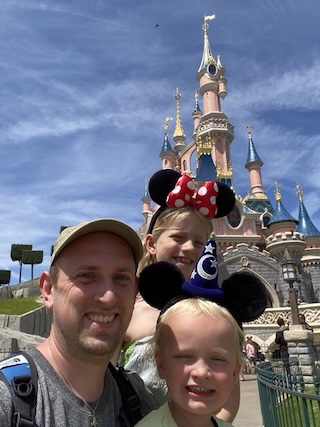
I took a week off to go to Paris and Disneyland with the kids and think things through. Because my wife had been well insured, the payout after her passing had cut our mortgage in half, and monthly pension payments were still coming for several more years. With 2.5 years of savings built up, I realised I could quit my job, be more present for the kids, and finally give my own apps real focus — at least for a while, with the hope that some income would eventually follow.
I resigned effective September 1st, 2022.
The project that made me believe I could go indie
For over a year, I had been working on a native macOS app using the App Store Connect API called AppDab. I initially used Antoine van der Lee’s excellent appstoreconnect-swift-sdk Swift package, but at the time many endpoints were missing, so I built my own generator for Apple’s OpenAPI spec — which became Bagbutik. I announced it on Twitter, and three days later Dave Verwer featured it in iOS Dev Weekly — a huge early confidence boost.
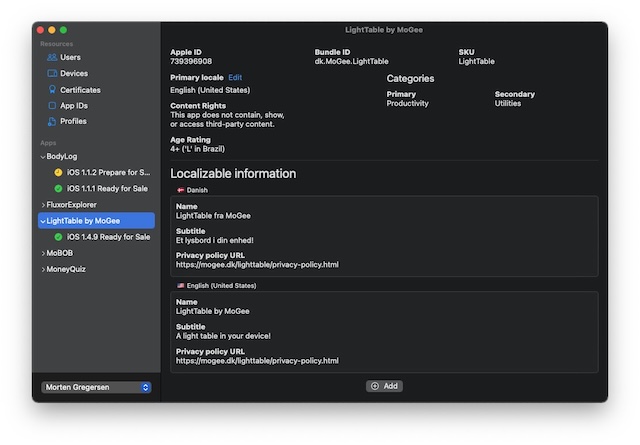
In March 2022, I shared a screenshot of AppDab on Twitter without saying what it was. A friend reached out privately asking about the app, and I gave him access. The response was unmistakable: “wowwww, it’s sooo fast! Can I tweet about this? It’s soo nice! So many people will love this”, and I knew I was working on something that would make other people’s lives better — something that motivates me deeply.
I opened TestFlight testing that May and got almost 300 testers over the summer.
Growing an audience… and then Elon happened
After I resigned, I figured I should work on building a following on Twitter (the place where app developers hung out back then). It went really well — I now had time to share much more and put effort into my tweets. I nearly reached 1,000 followers.
Things were going great for two months, but then Elon happened…
Just over a week before Elon Musk bought Twitter, I had created a profile for AppDab and started my launch buildup with videos showing how long common tasks took in App Store Connect/Apple Developer Portal vs. AppDab (e.g. creating certificates, creating provisioning profiles, expiring a beta build).
After Elon took over Twitter, many people started leaving the platform. His takeover hit at the worst possible moment — it happened only two weeks before my planned launch of AppDab on November 22nd, 2022. I had spent months building a following and preparing to share my app with the world — my first as an indie app developer — but suddenly many of the people I planned to reach disappeared. The atmosphere on the platform changed, and engagement dropped dramatically. It was frustrating, but I decided to launch anyway — I wanted the world to benefit from my app.
The silence after release
Based on the feedback I had received during the beta period, I was sure the launch would go really well and that many people would download AppDab. That didn’t happen...
Like many developers, I’m great at building the product, but I don’t really dare put on the marketing hat. I don't feel I have the skills, and developing the product is so much more fun. I felt like I was doing something to get attention — posting on Twitter and Mastodon for example — but I didn’t dare reach out to the media. I thought, that with a product this good, the media would automatically pick it up, even with me not reaching out.
In the first 3 months, around 300 people downloaded AppDab - mainly in the first couple of weeks. Out of those around 300 people, 8 bought a lifetime AppDab Pro and 2 started a yearly AppDab Pro subscription.
AppDab was mentioned in iOS Dev Weekly newsletter, and I think that drove much of the second spike in the chart.

The spring of new apps
The months after AppDab’s quiet launch turned into an intense little spring of shipping. Over roughly four months, I went from “maybe I should try to launch one more thing” to releasing four new apps in about three months: Score Wonders, Talkasy, Deep Dish Lie, and HeyAIku. It felt like all the ideas that had been piling up while I was employed suddenly had room to breathe — and instead of just prototyping, I actually finished and shipped them.
Some of that momentum probably came from the frustration of seeing AppDab not take off the way I had hoped — instead of waiting for traction, I threw myself into building the next thing (and the next, and the next).
At the same time, I kept polishing AppDab with smaller updates, and I opened up a TestFlight for another App Store Connect–powered tool called RawStoreConnect. That app let you query App Store Connect almost like it was a database, using a custom SQL-style language I called App Store CQL (Connect Query Language). Looking back, that spring wasn’t just about the number of apps I shipped — it was the first time I truly felt like an indie developer with real momentum.
Finally meeting the community in person
In the middle of all the app releases, 2023 also became the year when I finally tried attending app developer conferences.
In May, I travelled to Chicago for the very first edition of the Deep Dish Swift conference. It felt surreal to walk into a room full of people who cared about the same niche Apple‑developer details that I did, and even more surreal that I was there entirely on my own terms. No employer deciding whether it was “relevant enough.” No approvals. No budget committees. Just me, as an indie, choosing to invest in the community I love.
One of the biggest highlights was finally meeting people I had known for years but only online — through social media, iOS Dev Happy Hour, and Core Coffee — and discovering that those digital friendships translated effortlessly into real‑world ones.
And then June became even more unbelievable: I got a golden ticket to WWDC. I hadn't been to WWDC since 2012, when my first employer took me there. My last employer would never have sent me — not with the tech stack we had, where web technologies wrapped in a thin shell meant that WWDC simply wasn’t considered useful. So walking onto Apple Park’s campus, over a decade later and now as an indie developer, felt almost symbolic. Like a full‑circle moment I didn’t know I needed.


It was also the first time I had been away from my kids for several days in a row — and the first time I had been in different countries without them. That part was strange, but also a reminder that going indie wasn’t just about building apps; it was about building a life where opportunities like this were possible again.
Akryla and the iOS 17 betas
After the whirlwind spring and the conference season, I spent the summer of 2023 building a new app: Akryla. It was the first time I truly had the freedom to dive into the iOS beta period like I had always imagined — experimenting with new APIs while they were still fresh, and trying to build something that might catch Apple’s attention for the iOS 17 release.
Akryla used the new subject‑lifting APIs introduced in iOS 17, letting users pull people, animals, or objects out of their photos and turn them into wild, abstract, sometimes ridiculous pieces of art. I branded it as a way to create “crazy artwork” from your own images, and it was genuinely fun. The app also used Apple’s new SwiftData framework to store the artworks, which made it feel even more like a forward‑looking project.
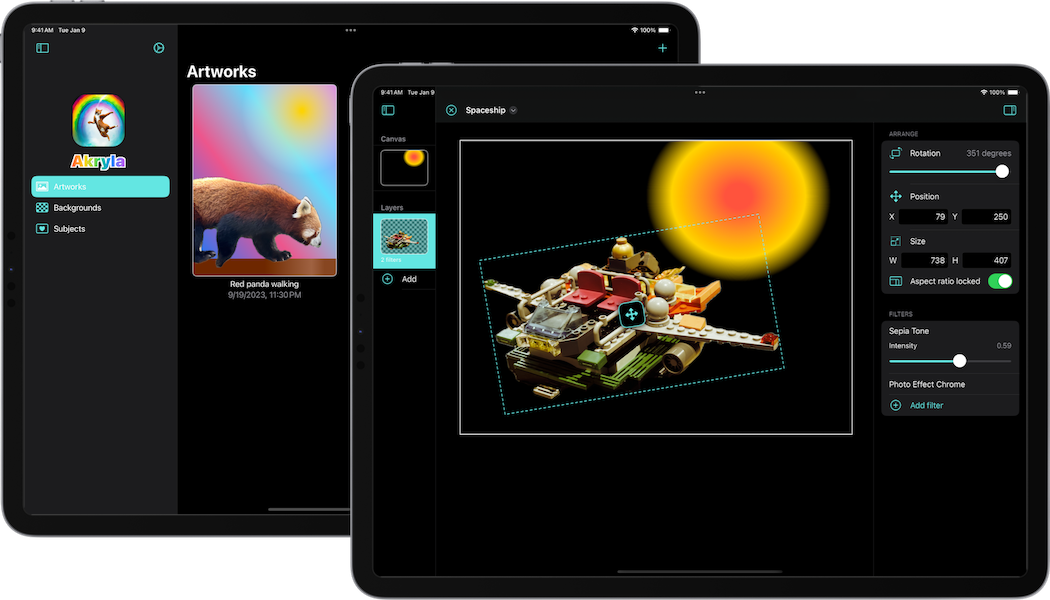
It was the closest I had ever come to making a “potentially feature‑worthy” app during a beta cycle. I worked hard through the summer to be ready for launch day — partly for the joy of it, partly in the hope that the timing and use of new technologies might give the app a little extra traction.
That didn’t happen.
Now, two years later, Akryla has been downloaded by only 31 people. After pushing so hard to hit the release window, I completely burned out. I couldn’t find the motivation to write code for a while, and it became clear that chasing Apple‑feature dreams wasn’t healthy for me — at least not when I was doing it alone.
Still, Akryla represents something important: the freedom to explore, to experiment, to build something weird just because I wanted to. And even if almost nobody downloaded it, it stands as a reminder of what that summer felt like — the first time I truly lived the indie‑beta‑developer life.
Unexpected freelance work — without really looking for it
During my first year as an indie, I wasn’t actively looking for freelance work — I mostly wanted to focus on my own apps. But because I finally had the freedom to contribute more to the community, I helped the WWDC Notes project by writing detailed summaries for several sessions. It was fun, meaningful work, and I treated it simply as a way to give back. I didn’t expect anything more to come from it.
But it did.
The Danish VoIP app
In the fall, a company in Denmark stumbled upon the notes I had written for the session “What’s new in voice processing”. They reached out, explaining that they were working on a new VoIP app — a MAUI rewrite of their old Xamarin app — and were stuck with their audio pipeline.
We set up a meeting, and even though my only audio experience was a brief experiment with AVAudioEngine and SFSpeechRecognizer for a prototype — and I hadn’t touched Xamarin/MAUI in years — I still helped them get unstuck. That turned into a request for more help, and we agreed on 1–2 months of freelancing, focused mainly on making their call audio crisp and clear.
It took a few weeks, but just before Christmas we got the audio quality to the level they were hoping for. Since they were simultaneously rebuilding the rest of the app and adding new features, they needed additional engineering help — so I returned after New Year’s and worked part‑time (20 hours/week) for them until November 2024, when the app was finally ready for launch.
The travel app from Germany
Then, right after New Year’s (2023/24), I received an email from a German developer. He and his girlfriend were building an app for people who love to travel. He handled all backend logic and algorithms, while a Dutch iOS developer had built the first version of the iPhone app. But that developer became busy, and they suddenly needed someone who could take over and keep the app moving forward.
The work was paid hourly, and I typically spent a couple of hours each week implementing features and helping shape the app. In September 2024, the project’s funding fell through, so work has been paused since — but it remains another example of how opportunities appeared simply because I was visible as an indie.
All of this freelance work arrived with almost no effort on my part. Simply by being indie, sharing my work, and contributing where I could, opportunities found me. He later told me that he found me through the content I posted — and through AppDab itself.
When competition arrived
In early 2024, something happened that I had quietly feared for a long time: a competitor arrived. Someone began building an app that aimed to do the same thing AppDab does — the same idea, the same purpose, the same audience.
On February 5th, 2024, he announced on Twitter that he was working on this new app. I had only seen a tiny piece of UI and a short description, but it hit me much harder than I ever expected. For many nights, I lay awake far too long, staring at the ceiling, thinking about what this new app might be, what it might mean for AppDab, and what would happen next. I also knew the developer behind it had a much larger following on social media, and I could see many people reacting very positively to the announcement — saying it was exactly what they needed, simply because they hadn’t heard about AppDab.
The intensity of the anxiety genuinely surprised me. I ended up scheduling a few one‑to‑one sessions with a psychologist, and I also talked a lot with good indie‑developer friends online, people who has apps in markets with much bigger competition. Those conversations ended up helping far more than I expected. Slowly, the fear turned into motivation.
Just two days after the announcement, I shipped a small update with some nice additions to the user experience. Two weeks later, a bigger update followed — a much more coherent user interface and a lot of quality‑of‑life improvements. Instead of freezing, I moved forward.
Then something even more unexpected happened: at the end of February, I noticed a spike in downloads. I thought it was because people got aware of AppDab, because of the competitor, but 2 months later found out the German site, ifun.de wrote about AppDab.

On March 9th, 2024, I opened up a TestFlight for AppDab on iOS and iPadOS. And one month later, I released the update with full iOS and iPadOS support — complete with a small commercial filmed with my daughter. It remains one of my favourite things I’ve ever made ❤️
I was just trying something to get people to notice AppDab.
The reception of AppDab on iOS was better than the initial launch on macOS.

Deep Dish Swift 2024 — friends, sponsorship, and Vanilla Coke
After how incredible the very first Deep Dish Swift was in 2023, there was never any doubt I’d return in May 2024. The sessions were great, yes — but what really pulled me back was the people. It’s a rare thing to find a conference where you can sit down with friends from all over the world, talk Swift until midnight, and feel completely at home. Deep Dish Swift had become that place for me.
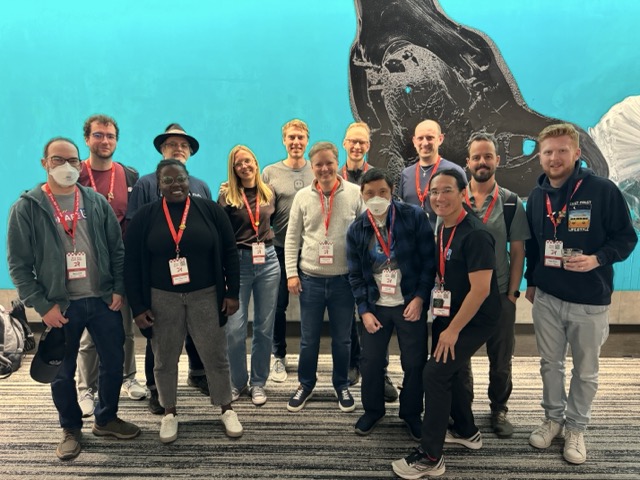
This year, however, I decided to show up not just as an attendee, but also as an indie developer trying to put myself — and AppDab — a little more out in the world. I reached out to Josh Holtz, the organizer, and we agreed that AppDab would be a Single Slice Sponsor. That meant a small shoutout from the stage and a raffle where five lucky winners would receive a promo code for one year of AppDab Pro. Hearing my app mentioned in front of a room full of developers I admire felt surreal — but also deeply motivating.
And then there was the Vanilla Coke situation... 😅
On the first day, I had ordered a couple of packs of Vanilla Coke to take home — something we can’t just buy in Denmark. But on the last morning, while packing my bags, I realised I couldn’t bring them all back home — it wasn’t planned, and honestly a bit annoying. At the same time, most attendees at Deep Dish Swift were exactly the people who could benefit from AppDab, and the whole idea struck me as a silly but fun way to be visible. So instead of wasting the extra cans, I decided to turn them into a tiny, playful piece of AppDab “marketing.”
So I brought the extra cans down to the conference, slapped AppDab stickers on them, and placed them neatly on a table by the back door.
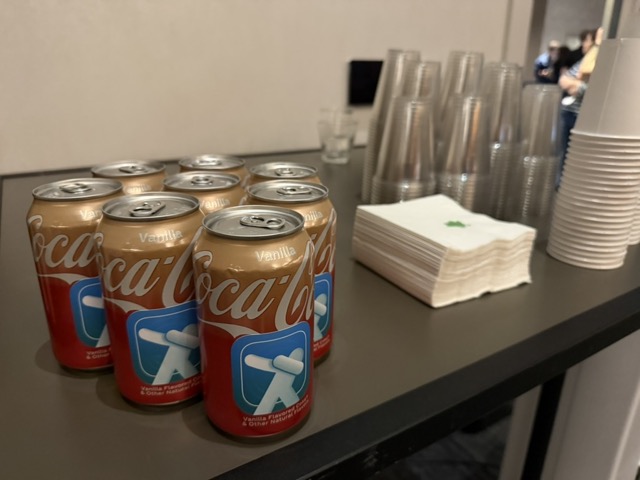
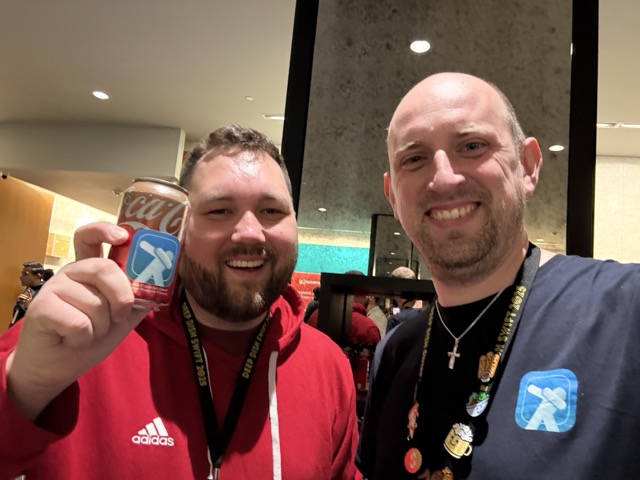
Building in public instead of chasing the new OSes
After Deep Dish Swift 2024, I returned home energized — but this time, I decided not to chase the new OS releases. No frantic late‑summer evenings trying to hit day‑one App Store availability. No betting on being featured for using the newest APIs. I had tried that with Akryla, and the burnout wasn’t something I wanted to repeat.
Instead, I tried something new: building an app in public.
At the conference, Jordi Bruin had encouraged me to pick a project, build it quickly, and ship it. I loved that idea. So I started working on Formulize, posting my progress regularly on social media — small updates, UI experiments, behind‑the‑scenes thoughts. It was fun in a way that building alone often isn’t. In September 2024, I released Formulize as part of RevenueCat’s Shipaton.
But life also had its own big milestone:
I got married in August 2024. ❤️
I took time off work and off coding, and it was absolutely worth pausing everything for.

When I returned, the “build fast and ship” mindset was still with me, and I started yet another small project: ClickClock. I managed to build and ship it in just two weeks — again as part of Shipaton. A tiny app, but incredibly satisfying to get out into the world so quickly.
This period reminded me that I didn’t always need to chase WWDC features or pour my energy into launch‑day pressure. Sometimes the joy of indie life is simply picking an idea, sharing the journey, and shipping something fun and/or useful.
Releasing AppDab Intelligence before Apple Intelligence
The fall of 2024 became an unexpected turning point for AppDab. Earlier that summer, Apple had announced Apple Intelligence, but due to regulatory complications it wasn’t included in the first versions of iOS 18 and macOS Sequoia in the EU. Still, the announcement planted an idea in my mind long before any of those features would actually ship.
I wanted AppDab to feel like it was moving into the future as well.
Throughout the summer and early fall, I started experimenting with integrating AI features directly into AppDab — things that would meaningfully help developers, not just look flashy. The result became AppDab Intelligence.
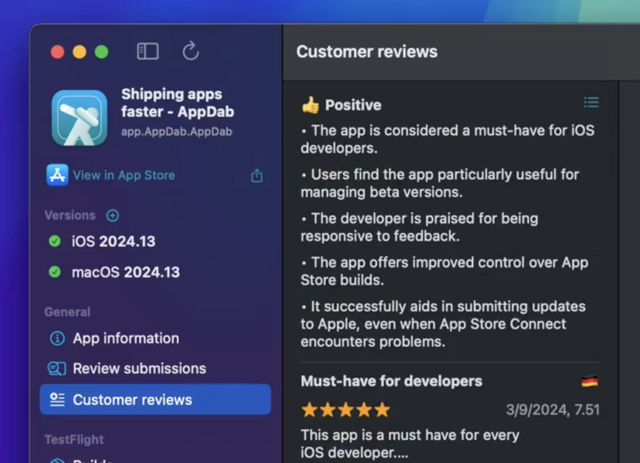
In October 2024, I released the first version. It introduced several genuinely helpful abilities:
- Translating app metadata into any language developers needed for their App Store submissions.
- Translating customer reviews into English, to help understand what the customer wrote.
- Summarizing customer reviews, giving developers quick insights without needing to scroll through dozens of long comments.
It was my first real step into bringing AI‑powered tools into AppDab, and the reception was warm. Even though Apple’s own Apple Intelligence wasn’t available in the EU yet, AppDab Intelligence was — and it added something genuinely useful for the people who rely on the app every day.
The update that transformed Score Wonders — and its revenue
In March 2025, I shipped the biggest update Score Wonders has ever seen. Until then, the app only supported scoring for the very first base game of 7 Wonders. Over several months, I rebuilt major parts of the app and finally added support for all the base games and every expansion — the full 7 Wonders ecosystem.
It was a massive project involving new scoring logic, new data structures, new UI, and a lot of testing. But when the update went live, the impact was immediate. You can actually see the spike in the proceeds chart — March 2025 stands out clearly.
To support the ongoing work, I introduced an annual subscription at $5.99 and raised the lifetime price from $0.99 to $14.99. It felt like a bold jump, but it turned out to be the right one. Players who relied on the app were happy to pay for the added value.
This update transformed Score Wonders from a small utility app into the ultimate scoring companion for 7 Wonders players. It remains one of the biggest milestones in my indie journey.

Deep Dish Swift 2025 — when “family” included me
In May 2025, I returned once again to Deep Dish Swift — and this year something happened that I’ll never forget.
During the conference intro, Josh Holtz stood on stage and talked about what Deep Dish Swift really was. Not just a conference. Not just talks. But Deep Dish Swift takes a family. And then he began showing slides of what that family looked like: his wife Kari, who helps organize the event; Chris Lindsay, who handles the practical chaos in the days leading up to it; Kai and Malin, who record podcast episodes with the speakers each year.
And then… a slide of me.
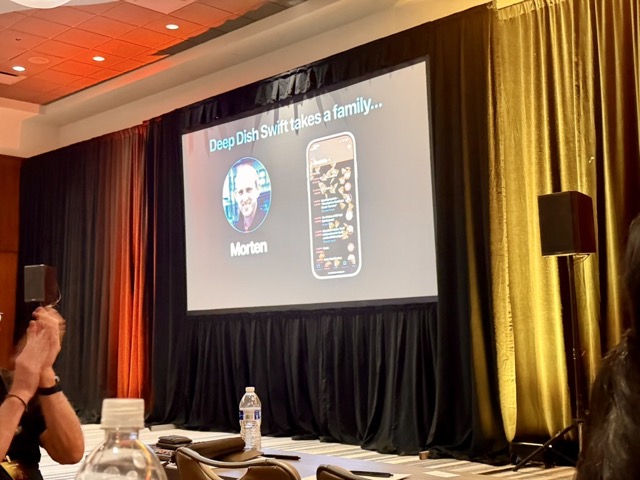
Because I had created the Deep Dish Unofficial app — and in 2025 I had taken it to completely new heights: now it was not just on iOS, but on macOS, tvOS, watchOS, and visionOS as well. Matt Heaney and I had added an App Clip so people could quickly view the schedule, and I had added a silly little pizza confetti feature that ended up being one of the most‑loved parts of the app.
Seeing my work acknowledged from the stage, in front of the entire community, was incredibly emotional. I’ve never felt more included, more appreciated, or more connected to the indie‑dev world than in that moment. Deep Dish Swift really is family — and this year, Josh made me feel like I was truly part of it.
I also repeated the little tradition I had accidentally started the year before: bringing Vanilla Coke to share. But this time, I came prepared — I already knew there probably wouldn’t be room in my suitcase for all the cans. So once again I brought the extras to the conference, added AppDab stickers, and let people grab a cold Vanilla Coke on their way between sessions. A small, silly thing — but it brought smiles, and it felt like a fun continuation of that indie-developer spirit from the year before.
Miniotaur — a maze app born from a dot‑grid notebook
One of the most meaningful projects of my indie journey didn’t begin as an app idea at all. It started when I gave my son, Andreas, a small dot‑grid notebook — a piece of conference swag I had brought home from Deep Dish Swift 2024. He immediately began filling it with hand‑drawn mazes. Page after page, new paths, twists, dead ends, and clever little traps appeared.
Watching him create those mazes was the spark.
At first, I thought it would simply be a fun father‑son activity. But the more he drew, the clearer it became that there was something wonderfully creative — and wonderfully interactive — about what he was doing. So we decided to turn his notebook hobby into an app we could build together.
That became Miniotaur.
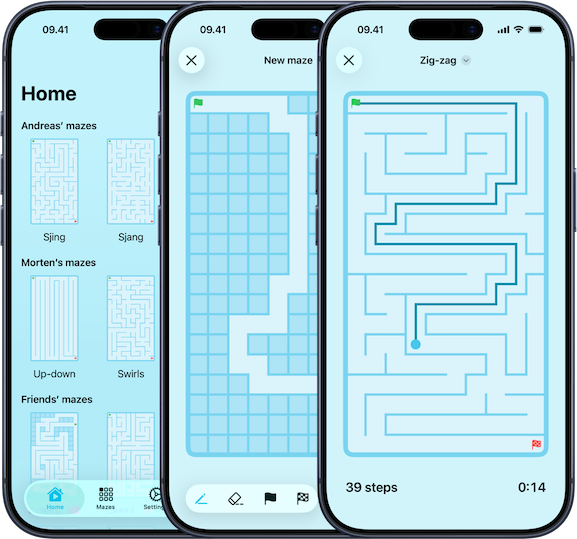
In Miniotaur, there are no predefined levels. Users create their own mazes using a simple editor, and then share them with friends or challenge themselves to solve what they’ve built. Andreas helped shape the earliest ideas, drew UI sketches, tested early versions sitting next to me, helped with brainstorming, and sat on my lap as we drew the icon and tweaked the liquid-glassiness. The app carries his fingerprints all over it — figuratively, and occasionally literally on my screen.
Miniotaur isn’t my biggest app, or my most technical, or the one that took the longest. But it’s one of the most personal. It’s a reminder of why I went indie: to have the freedom to build things that bring joy, to include my kids in the journey, and to turn small everyday moments — like a dot‑grid notebook full of mazes — into something we can share with the world.
And of course we celebrated the launch it with cake, soda and candy!
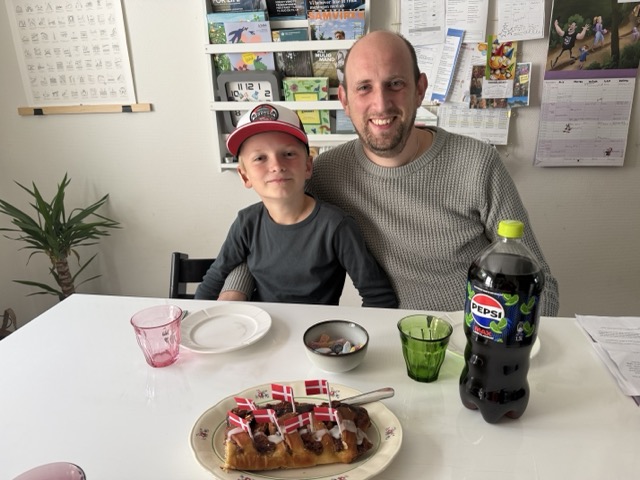
The financial reality of going indie
Before wrapping up, I want to share something important — because it can be easy to read indie‑dev stories and imagine that the revenue eventually catches up to the work. That hasn’t been my reality.
From September 1st, 2022, to November 20th, 2025, the total amount I’ve earned from all my apps on the App Store is:
💰 $2,865.48 USD
Here’s how that amount breaks down across my apps:
Score Wonders: $1,353.13 AppDab: $856.16 LightTable: $398.87 Miniotaur: $102.81 Deep Dish Unofficial (tip jar): $104.78 HeyAIku (tokens): $22.83 Talkasy: $19.72 Formulize: $4.75 ClickClock: $2.43
It came from a mix of premium upgrades, subscriptions, tip jars, and small purchases across all of my apps — with Score Wonders and AppDab accounting for the majority of it. Some apps did okay. Some made nothing. Most made far less than people might expect from the outside.
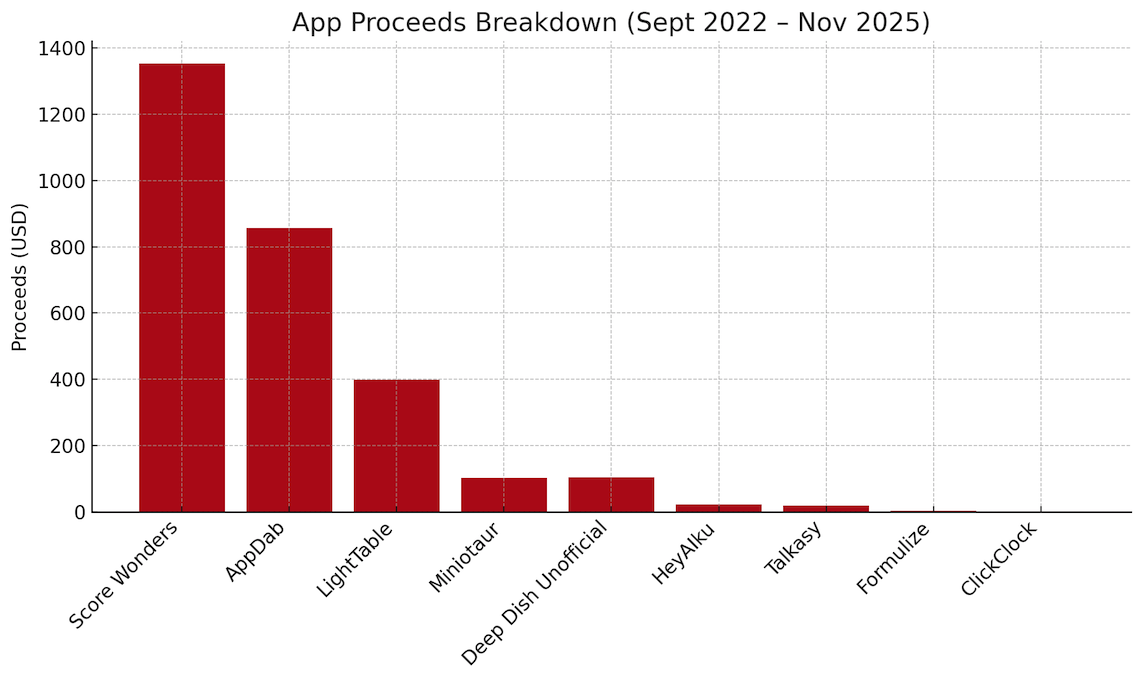
Over these years, I’ve also tried to give AppDab more visibility through various indie‑friendly efforts — sponsoring AppDab Pro licenses for multiple competitions and community events, offering birthday giveaways, running introductory offers and seasonal discounts (including Cyber Monday), and participating in initiatives like Indie App Sales. These experiments didn’t move the revenue needle much, but they helped build goodwill and put AppDab in the hands of more developers. I also sponsored Indie App Sales itself on one occasion.
One bright milestone did appear a couple of weeks ago, where I crossed 100 active subscribers across my apps for the first time. It’s still a small number in the grand scheme of things — but it felt huge to me. A quiet signal that people not only liked my apps, but trusted them enough to support them long‑term. That little milestone meant more to me than any revenue spike.
I also earned money through the freelancing I did in 2023 and 2024 — work that arrived unexpectedly and helped bridge the financial gap. That freelance income was essential, but even combined with the app revenue, it still wasn’t enough to live on.
And the truth is this:
The only reason the indie life has been financially possible is because of the pension payments and savings I received after my wife passed away.
Without that safety net, I would not have been able to spend these years building apps, attending conferences, experimenting, or growing the way I have.
The apps haven’t supported me financially — not yet.
But they have supported me emotionally, creatively, socially, and professionally.
And sometimes those things matter just as much.
Looking back — three years later
When I look back at these three years, it doesn’t feel like a career move. It feels like a life shift.
I’ve shipped more apps than I ever imagined, learned technologies I never thought I’d touch, built tools that people genuinely depend on, and found myself in the middle of a community that has become a second family. I’ve had moments of doubt, nights of panic, stretches of burnout, and launches that went nowhere — but also moments of pride, unexpected freelance opportunities, deep friendships, and small wins that meant the world to me.
And I’ve learned one lesson that’s important to say out loud:
this indie life was only possible because I had financial runway.
Between the pension payments and the savings that supported me after my wife passed away, I had the space to rebuild my life and rediscover my creativity. My apps have not earned enough to live off — not even close — but they gave me purpose and a path forward at a time when I needed both.
Moments like the Score Wonders revenue spike gave me hope — proof that good work can land — but they were still only moments, not a stable income.
What have I learned?
- That going indie isn’t linear. It’s momentum, stalls, randomness, and resilience.
- That the things you build quietly in the evenings sometimes matter to people you’ve never met.
- That sharing your work — even imperfectly — opens doors you don’t see yet.
- That competition can feel terrifying… but can become motivation.
- That building with my kids brings a kind of joy no revenue chart will ever match.
- success isn’t defined by earnings, but by freedom — the freedom to choose what to work on, who to help, and how to spend my time.
Was it worth it?
Yes. Absolutely yes.
Going indie gave me time with my kids when they needed it most.
It gave me the space to rebuild my life on my own terms.
It gave me curiosity back. Confidence back. Community back.
And it gave me the belief that I can build things that matter — even if they don’t (yet) make enough money to live on.
I don’t know exactly where the next three years will take me. Maybe AppDab will grow. Maybe one of the tiny apps will take off. Maybe something unexpected will appear, like so many things already have.
But I do know this:
Going indie was the right choice — for my kids, for my creativity, and for myself.
If there’s anything the past three years have taught me, it’s that unexpected things happen when you simply keep building. I don’t know exactly what’s coming — but I know I’ll keep going.
Thank you
If you made it all the way to the end of this very long post — thank you.
And if you’re building your own apps, I hope you’ll consider trying AppDab.
It’s a tool I’ve poured years into, shaped by everything you’ve just read — and made specifically to make indie developers’ lives a little easier.
You can learn more at https://AppDab.app ❤️
Tagged with: